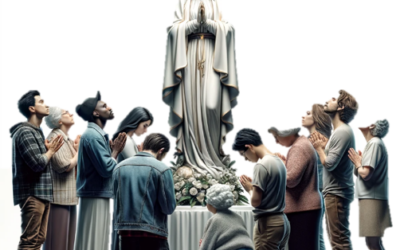The Roman Catholic Church holds to the view of the Lord’s Supper called transubstantiation. It is the view that the bread and the wine become the actual body and blood of Christ, yet still retain the appearance of bread and wine.
“The Council of Trent summarizes the Catholic faith by declaring: ‘Because Christ our Redeemer said that it was truly his body that he was offering under the species of bread, it has always been the conviction of the Church of God, and this holy Council now declares again, that by the consecration of the bread and wine there takes place a change of the whole substance of the bread into the substance of the body of Christ our Lord and of the whole substance of the wine into the substance of his blood. This change the holy Catholic Church has fittingly and properly called transubstantiation (CCC 1376).'”
Because of this view, the Catholic Church also says that the Mass (the ceremony of the Lord’s Supper) is a sacrifice (CCC 1055, 1365), the same sacrifice of Christ (CCC1367), that is propitiatory (CCC 1367), and capable of making reparation of sins (CCC 1414). This is because of their position that the bread and the wine become the sacrificed body and blood of Christ.1
In light of this, Catholics routinely say that their view of the Lord’s Supper and transubstantiation was universally held by the Early Church Fathers. But, that claim is not true.
The following paragraph is provided as a unit so that you can review it, as well as copy and paste it, into various online media in order to demonstrate that the Roman Catholic view is incorrect. The following quotes demonstrate that not all Early Church Fathers agreed with the present Catholic view. I’ve underlined the important parts.
“Catholics routinely say that the all the Church Fathers agreed with the Roman Catholic view of the Eucharist and transubstantiation. That’s not true. “But if it be unlawful even to speak of this, and if for men to partake of the flesh of men is a thing most hateful and abominable, and more detestable than any other unlawful and unnatural food or act,” (Athenagoras 133-190 AD, On the Resurrection of the Dead, 8). ** “For if sacraments had not some points of real resemblance to the things of which they are the sacraments, they would not be sacraments at all. In most cases, moreover, they do in virtue of this likeness bear the names of the realities which they resemble.” (Augustine, 354-430 AD, Letter 98:9). ** “‘Except ye eat the flesh of the Son of man,’ says Christ, ‘and drink His blood, ye have no life in you.’ This seems to enjoin a crime or a vice; it is therefore a figure, enjoining that we should have a share in the sufferings of our Lord,” (Augustine, 354-430 AD, On Christian Doctrine, 3:16:24). ** “And He blessed the wine, saying, ‘Take, drink: this is my blood’ – the blood of the vine. He figuratively calls the Word ‘shed for many, for the remission of sins’ – the holy stream of gladness.’” (Clement of Alexandria, 150-215 AD, The Instructor, 2:2). ** “Elsewhere the Lord, in the Gospel according to John, brought this out by symbols, when He said: ‘Eat ye my flesh, and drink my blood,’ describing distinctly by metaphor the drinkable properties of faith and the promise, (Clement of Alexandria, 150-215 AD, The Instructor, 1:6). ** For just as he, who was priest of the Gentiles, is not represented as offering outward sacrifices, but as blessing Abraham only with wine and bread, in exactly the same way our Lord and Saviour Himself first, and then all His priests among all nations, perform the spiritual sacrifice according to the customs of the Church, and with wine and bread darkly express the mysteries of His Body and saving Blood.” (Eusebius, 263-339 AD, Demonstratio Evangelica, 5:3). ** “For again, He gave Himself the symbols of His divine dispensation to His disciples, when He bade them make the likeness of His own Body… to give them bread to use as the symbol of His Body,” (Eusebius, 263-339 AD, Demonstratio Evangelica, 8:1). ** “…nor the bread by which he represents his own proper body, thus requiring in his very sacraments the ‘beggarly elements’ of the Creator,” (Tertullian, 155-220 AD, Against Marcion, 1:14).
Conclusion
As you can see, there were plenty of Early Church Fathers who did not hold to the idea of transubstantiation. Many of them taught that the Bread and Wine were symbolic. Of course, there were Church Fathers who held to a similar view of the Roman Catholic transubstantiation – though not articulated in the same way. So, when a Roman Catholic says that the Early Church Fathers unanimously held to the Catholic position, it is simply not true.
References
| 1↑ | The CCC is the Catechism of the Catholic Church. You can check the paragraphs at http://www.scborromeo.org/ccc.htm |
|---|





